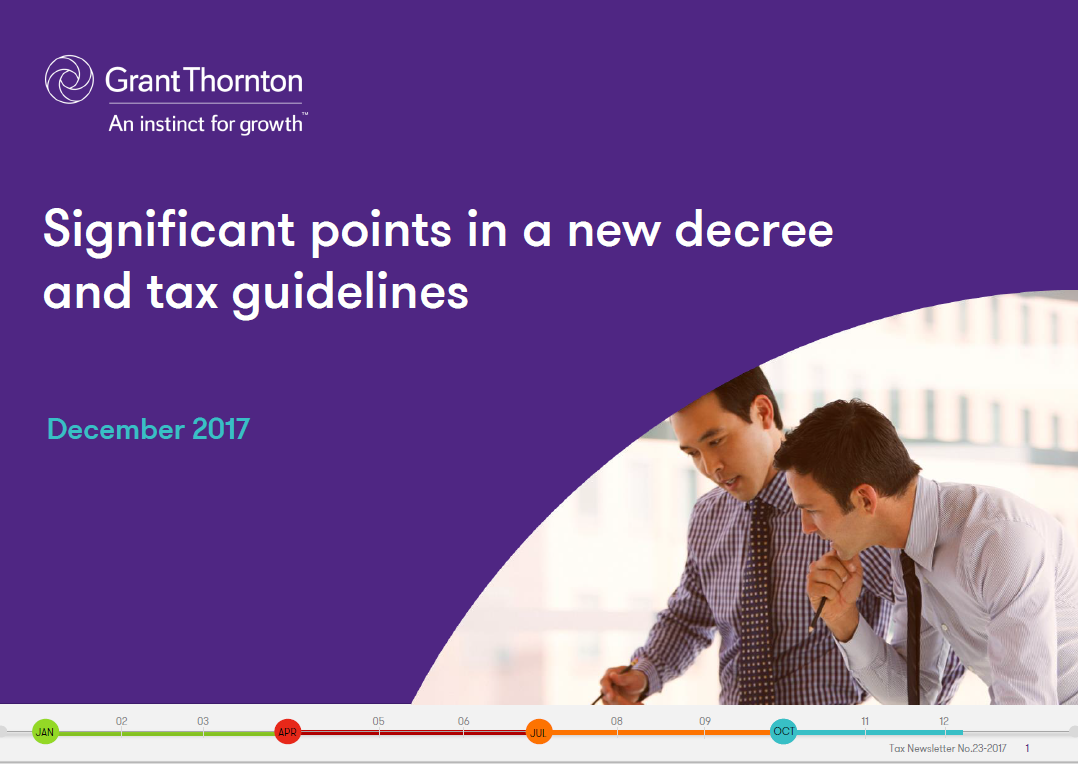-
International Financial Reporting Advisory Services
IFRS reporting advisory serivces of Grant Thornton are carried out by our dedicated team with expertise in IFRS implementation.
-
Audit Services
• Statutory audit • Review of financial statements and financial information • Agreed-upon procedures • FRAS services • Compilation of financial information • Reporting accountant • Cross-border audit • US GAAP audit
-
Audit Quality
We have various methods of monitoring our system of quality control and engagement quality, including real-time involvement of coaches and national office personnel on select audit engagements, reviews of issuer audit engagements prior to archiving by someone outside of the engagement team, and internal inspections of assurance engagements and the system of quality control.
-
Audit Approach
Audit Approach
-
Licensing services
Licensing services
-
International tax planning
Our extensive international network provides us with significant resources to meet all your expansion goals. We strive to develop commercially focused and tailored tax strategies to minimise tax exposures and maximise business efficiency.
-
Expatriate tax planning
We have a broad knowledge base and skills to assist you keep your personal income taxes to a legitimate and reasonable level, while remaining compliant with legislation. We can develop a personalised package for each key employee to take maximum advantage of the exemptions and incentives available.
-
Tax advisory
We will review the proposed business model and transactions and advise on tax implications and recommendations to optimize the tax opportunities under the local regulations and treaties which Vietnam entered into. Furthermore, we coordinate with our GT global tax team to provide a comprehensive tax advisory for the countries involved in the business model and transactions.
-
Tax compliance services
This service is designed to assist enterprises to cope with the statutory tax declaration requirements in line with the Vietnamese tax laws as well as the frequent changes and updates in tax laws.
-
Tax health check
Our Tax Health Check involves a high-level review of specific tax areas to highlight the key issues that need to be rectified in order to reduce tax risks. Through our extensive experience, we have identified key risk areas in which many enterprises are not fully compliant or often overlook potential tax planning opportunities. Our tax health check service represents a cost-effective method to proactively manage risks and reduce potential issues arising as a result of a tax inspection.
-
Transfer Pricing
Transfer pricing is a pervasive tax issue among multinational companies. In Vietnam, the tax authorities require special documentation to report related party transactions. Compliance with transfer pricing regulations is an important aspect of doing business effectively in Vietnam as failure to do so may result in significant penalties.
-
Tax due diligence
We conduct tax due diligence reviews of target companies to analyse their tax exposure and position in relation to acquisitions, mergers or consolidations. We are able to integrate this service with our Advisory Services department in order to offer a comprehensive, holistic due diligence review.
-
Customs and international trade
Our experienced professionals can help you manage customs issues more effectively through valuation planning and making use of available free trade agreements. We also assist Clients in optimising their customs procedures by making use of potential duty exemptions and efficient import-export structures. Risk mitigation activities include customs audit defense and compliance reviews.
-
M&A Transaction
We advise numerous foreign investors on efficient tax structures for their investments. Our experience allows you to consider all the options and set up a corporate structure that meets both operational and tax efficiency requirements. In short, the structure that is best for you.
-
Industrial Zones – Picking A Location For Your Business
Grant Thornton Vietnam’s one-stop services are designed to provide comprehensive support to both new and current investors who are planning to expand or restructure their business in Vietnam. Our professionals have established strong working relationships with landlords, property developers and authorities at various localities. With extensive experiences in liaison with the relevant agencies, we offer assistance including negotiation on land rental rates and efficient management of licensing process. Our customized and flexible solutions can bring benefits of cost efficient location, accelerate licensing process, and optimize tax opportunities while remaining in compliance with legislation.
-
Tax Audit Support
Tax audit support services provide comprehensive assistance to your business in Vietnam. Recent tax practices have shown the general tendency of launching routine tax audit on yearly basis. Tax authorities have been effectively using more sophisticated methods to identify target entities from across different industry sectors.
-
Business Risk Services
Business Risk Services
-
Transaction Advisory Services
Transaction Advisory Services
-
Valuation
Valuation
-
Business consulting services
Finance Management Advisory
-
Accounting services
Accounting services
-
Taxes compliance within outsourcing
Taxes compliance within outsourcing
-
Payroll, personal income tax and labor compliance
Payroll, personal income tax and labor compliance
-
Secondments/Loan staff services
Secondments/Loan staff services
-
Compilation of the financial and non-financial information
Compilation of the financial and non-financial information
-
Accounting systems review and improvement
Accounting systems review and improvement
-
Initial setting-up for accounting and taxes systems
Initial setting-up for accounting and taxes systems
-
Management accounting and analysis
Management accounting and analysis
-
Comprehensive ERP system solution
ERP software is a tool for business operations, production management, order processing and inventory in the business process. Today, ERP software for small and medium businesses has been greatly improved to help businesses manage their business better. The article below will answer all relevant information about what ERP software is and offer the most suitable ERP solution for businesses. Let's follow along!
-
Analyze Business Administration data
We believe in the value that data can bring to the success and development of every business. Our team helps design data architecture supported by tools, to support business governance and provide useful information to management.
-
Financial reporting compliance solution package
Putting financial issues at the heart, this service helps ensure that financial reports for customers comply with both the requirements of Vietnamese accounting regulations and standards (VAS) as well as reporting standards. international finance (IFRS).
-
Third-party ERP extensions
ERP is a long-term solution that requires long-term travel, not short-term. We understand that many businesses cannot deploy the entire ERP system at once due to many different reasons, instead businesses can deploy each part. Over time, these solutions can be expanded to accommodate improved business processes or can even link completely new processes across different departments.
-
Localize, deploy and rebuild the project
Quite a few ERP projects need to be implemented according to current Vietnamese requirements and regulations, but still comply with common international business requirements. These projects need some improvements and adjustments in the right direction.
-
Consulting on technology solutions
We support the selection and implementation of the most suitable solutions, ensuring business efficiency and performance. We will work closely with customers to plan, evaluate and implement the right technology investment strategies and solutions to meet the development needs of businesses.

-
Offshore company establishment service
Using the offshore company model will facilitate the owner in the process of transaction and expand overseas markets, take advantage of the tax policy with many incentives and protect the value of the family enterprise's assets.
-
Private Trust Advisory
The development of the economy with many modern financial instruments has brought many advantages and opportunities for the enterprises, but there are still certain potential risks in any type of business. So how to protect your asset value with an appropriate company structure while stay compliance with relevant regulations?
-
Our values
We have six CLEARR values that underpin our culture and are embedded in everything we do.
-
Learning & development
At Grant Thornton we believe learning and development opportunities help to unlock your potential for growth, allowing you to be at your best every day. And when you are at your best, we are the best at serving our clients
-
Global talent mobility
One of the biggest attractions of a career with Grant Thornton is the opportunity to work on cross-border projects all over the world.
-
Diversity
Diversity helps us meet the demands of a changing world. We value the fact that our people come from all walks of life and that this diversity of experience and perspective makes our organisation stronger as a result.
-
Contact us
Contact us
-
Available positions
Experienced hires
-
Available positions
Available positions
1. The notable points in Official Letter No. 7380/TCHQ-TXNK dated 09 November 2017 issued by the General Department of Customs relating to tax treatment on imported goods.
On 9 November 2017, the General Department of Customs has issued Official Letter No. 7380/TCHQ-TXNK on tax treatment on imported goods. Accordingly, the following points should be noted:
Import duty on goods imported for manufacture of exports but destroyed later
- Goods imported for manufacturing exports but destroyed later are not subject to import-duty exemption.
Taxable value of refuse, scrap, redundant raw materials and supplies whose use is converted to sales in the domestic market
- For surplus raw materials and supplies, customs value is the purchase price of goods at the first importing checkpoint, which was declared in the initial customs declaration form.
- For refuse and scrap during manufacturing, customs value is the actual or future payment at the time of changing the use. Customs authorities determine the customs value based on rules, valuation method, database and relevant documents.
2. Guidance on foreign exchange rate used for calculating Foreign Contractor Tax (“FCT”)
On 6 October 2017, the General Department of Taxation issued Official Letter No. 4587/TCT-CS to confirm that the guidelines mentioned in Official Letter No. 2935/TCT-CS dated 3 July 2017 addressed to Yen Bai Tax Department and Phu Tho Tax Department regarding the foreign exchange rate used for computing FCT is only applicable to the specific cases of these two tax departments. Their cases are associated with foreign contractors carrying out Official Development Assistance (“ODA”) projects. In other words, it is noting that Official Letter No. 2935/TCT-CS is not applied in all circumstances.
Thus, enterprises should carefully consider applying the appropriate exchange rates for calculating FCT, in compliance with current regulations as well as refering to other guidance of local tax departments in advance.
3. Declaration and update of information relating to the personnel in charge of accounting, or performing chief accountant services in accordance with the current legislation
The General Department of Taxation issued Official letter No. 4564/TCT-KK dated 05 October 2017 providing guidance on declaring, updating information of personnel in charge of accounting, or performing chief accountant services as follows:
Some enterprises only have personnel in charge of accounting instead of a chief accountant. Under the current regulations, individuals performing accounting services or chief accountant services have the rights and responsibilities of a chief accountant in accordance with Article 55 of Accounting Law. However, in the “Application Form for Enterprise Registration” and “Notification Form on changes in enterprise registration information” attached to Circular 20/2015/TT-BKHDT dated 01 December 2015 issued by Ministry of Planning and Investment, there is only a section to declare information of the chief accountant. There is no section to declare information on personnel in charge of accounting or performing chief accountant services. Consequently, such information cannot be transferred to the tax authorities.
Accordingly, in order to ensure the consistent application of regulations on chief accountants and personnel in charge of accounting, as well as to support tax authorities in obtaining sufficient information for tax management, the General Department of Taxation suggested to the Business Registration Department – Ministry of Planning and Investment considering and having written guidance to enterprises on completing information about “personnel in charge of accounting” or “personnel performing chief accountant service” on the above-mentioned Forms.
4. Value Added Tax calculation method in case of late submission of Form 06/GTGT
On 13 November 2017, the General Department of Taxation issued Official letter No. 5232/TCT-CS guiding VAT calculation method in the case of late lodgement of Form 06/GTGT – Notification on the applied VAT calculation method. Accordingly, in case enterprises, at the year-end, submitted Form 06/GTGT (to notify the application of credit method) to the tax department after the statutory deadline, but actually issued VAT invoices in the following year, these enterprises can be allowed to continue applying VAT credit method.
5. Some noteworthy points relating to Engineering Procurement and Construction (“EPC”) contracts
The Ministry of Construction issued Official letter No. 2525/BXD-KTXD dated 26 October 2017 providing guidelines on EPC contracts. In particular:
For sub-contract value:
- The EPC contractor cannot sub-contract more than 60% of the work within the EPC contract.
For definition of contract compensation and responsibility limitation
- For projects sponsored by state budget, the contractual penalty cannot exceed 12% of the violating part of the contract.
- The guarantee value for conducting projects is determined from 2% to 10% of contract value. In the event of preventing high risk, the guarantee amount for conducting projects can be higher but cannot exceed 30% of the contract value and must be approved by the relevant investment decision maker.
6. Tax provisions on Merger and Acquisition (“M&A”)
The Ministry of Finance has recently issued Official letter No. 14881/BTC-CST dated 3 November 2017 to give some guidance on tax provisions on merger and acquisition transactions, in which:
Value Added Tax
According to Point b, Clause 7, Article 5, Circular 219/2013/TT-BTC, when circulating assets of a merging party, the enterprise is not required to issue invoice and declare VAT. Instead, the enterprise will prepare an asset circulation order enclosed with documents about the assets origin.
Corporate Income Tax
- For revaluating assets after merging
The merged party is obligated to finalise its Corporate Income Tax (“CIT”) liability upto the point of merging and fulfill its tax liabilities in compliance with Article 16, Circular 151/2014/TT-BTC. Accordingly, the figures declared on tax finalisation returns are the current values, not the revaluated value of assets.
The merging party is allowed to revaluate assets to record in the accounting books. Any increase or decrease between the actual payment (to acquire the merged party) and the revaluated asset value can be recorded as an increase or decrease in other income should be depreciated or amortised based on the revaluated asset value.
- For loan interest
Loan interest incurred before 2015 from acquiring another enterprise are to be included in the acquisition price when transferring investment capital. Otherwise, it is considered as an expense if incurred from 2015 onwards.
Please contact our professional advisors at Grant Thornton Vietnam for assistance with taxation, work permits for expatriate and legal issues you may have during the course of your business.





